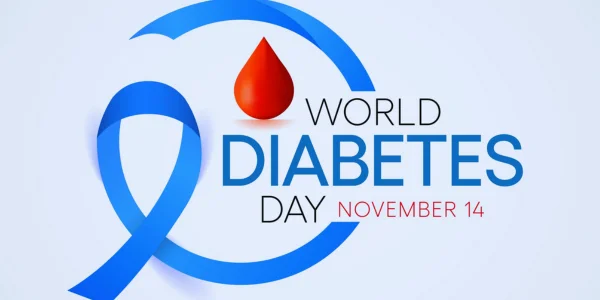Observed annually on November 14, World Diabetes Day is a global awareness campaign led by the International Diabetes Federation (IDF) and recognized by the United Nations (UN). The day serves to highlight the growing prevalence of diabetes worldwide, promote public awareness, and encourage effective management and prevention strategies.
This article delves into the origins, significance, themes, and global impact of World Diabetes Day while shedding light on the steps individuals and communities can take to combat this chronic condition.
History and Origins

World Diabetes Day was established in 1991 by the International Diabetes Federation (IDF) and the World Health Organization (WHO) in response to the alarming rise in diabetes cases worldwide. In 2006, the United Nations General Assembly adopted a resolution recognizing November 14 as a UN observance, making it the only UN health-specific day. The date was chosen to honor the birthday of Sir Frederick Banting, one of the co-discoverers of insulin in 1921, a life-saving treatment for diabetes.
Significance of World Diabetes Day
Diabetes is a chronic disease that occurs when the body cannot effectively regulate blood sugar levels due to inadequate insulin production or utilization. There are three main types:
- Type 1 Diabetes: An autoimmune condition where the body produces little or no insulin.
- Type 2 Diabetes: A largely preventable form linked to lifestyle factors, where the body becomes resistant to insulin or doesn’t produce enough.
- Gestational Diabetes: Temporary high blood sugar during pregnancy, increasing the risk of complications.
Globally, diabetes affects over 537 million adults (as of 2021) and is projected to impact 783 million by 2045. Left unmanaged, it can lead to severe complications, including heart disease, kidney failure, blindness, and limb amputations. World Diabetes Day aims to:
- Raise awareness about the risks and symptoms of diabetes.
- Promote the importance of healthy lifestyles in preventing Type 2 diabetes.
- Advocate for affordable and accessible diabetes care.
- Highlight the need for early diagnosis and effective management.
Themes of World Diabetes Day
Each year, World Diabetes Day focuses on a specific theme to address critical aspects of diabetes care and prevention. The theme for 2021-2023 is “Access to Diabetes Care: If Not Now, When?”, emphasizing the urgent need for:
- Uninterrupted access to insulin and other essential medications.
- Availability of diagnostic tools and regular monitoring.
- Affordable healthcare for all, especially in low- and middle-income countries.
Past themes have tackled issues like diabetes education, promoting healthy diets, and advocating for global action to curb the rise in diabetes cases.
The Global Burden of Diabetes
Diabetes is a significant public health challenge, contributing to millions of deaths and reduced quality of life. Key statistics include:
- Deaths: In 2021, diabetes caused approximately 6.7 million deaths, making it one of the leading causes of mortality worldwide.
- Healthcare Costs: The global economic burden of diabetes is estimated at $966 billion, driven by medical expenses and lost productivity.
- Undiagnosed Cases: Nearly 1 in 2 adults with diabetes remains undiagnosed, increasing their risk of complications.
- Children and Adolescents: Over 1.1 million children and adolescents live with Type 1 diabetes, highlighting the need for targeted interventions for younger populations.
How World Diabetes Day is Observed
World Diabetes Day is marked by various activities and initiatives worldwide to promote awareness and action:
- Public Awareness Campaigns: Governments and organizations use media, workshops, and community events to educate people about diabetes prevention and management.
- Screening and Diagnosis: Free health check-ups and screenings are organized to identify undiagnosed cases.
- Educational Events: Schools, workplaces, and healthcare institutions host sessions on healthy eating, exercise, and recognizing diabetes symptoms.
- Landmark Illuminations: Iconic landmarks around the world are lit up in blue, the official color of diabetes awareness, symbolizing unity in the fight against diabetes.
- Fundraising Events: Walks, runs, and charity drives raise funds for diabetes research, education, and support programs.
Preventing and Managing Diabetes
While Type 1 diabetes cannot currently be prevented, Type 2 diabetes, which constitutes about 90% of all diabetes cases, is largely preventable. Effective strategies include:
- Healthy Eating: Incorporate a balanced diet rich in fruits, vegetables, whole grains, and lean proteins while limiting processed foods and sugary beverages.
- Regular Exercise: Engage in at least 150 minutes of moderate physical activity per week to maintain a healthy weight and improve insulin sensitivity.
- Routine Check-Ups: Regular monitoring of blood sugar levels, cholesterol, and blood pressure can help detect issues early.
- Avoid Tobacco and Limit Alcohol: Smoking increases the risk of diabetes-related complications, while excessive alcohol can impact blood sugar levels.
- Medication Adherence: For those diagnosed with diabetes, following prescribed treatments and monitoring plans is critical for managing the condition effectively.
Challenges in Tackling Diabetes
Despite advancements in medicine and technology, significant challenges persist:
- Access to Insulin: Insulin, discovered over 100 years ago, remains out of reach for many due to high costs and limited availability.
- Health Inequalities: Socioeconomic disparities leave millions without access to basic diabetes care.
- Rising Obesity Rates: The global obesity epidemic is a major driver of Type 2 diabetes.
- Misinformation: Lack of awareness about diabetes symptoms, risks, and prevention strategies exacerbates the problem.
The Role of Technology and Innovation
Innovations in healthcare are transforming diabetes management. Key advancements include:
- Continuous Glucose Monitoring (CGM): Devices that provide real-time blood sugar readings, improving control and reducing complications.
- Digital Health Platforms: Apps and telemedicine services that offer personalized guidance and support for patients.
- Artificial Pancreas Systems: Closed-loop systems that automate insulin delivery, mimicking natural insulin regulation.
These tools make diabetes management more effective and accessible, empowering patients to lead healthier lives.
Conclusion
World Diabetes Day is a vital platform to spotlight the growing burden of diabetes and the urgent need for action. By raising awareness, promoting prevention, and advocating for equitable access to care, this day inspires global efforts to tackle diabetes and improve the lives of those affected. As individuals, communities, and nations, let us work together to ensure that everyone has the tools and support needed to prevent and manage this chronic condition. Together, we can make a meaningful impact in the fight against diabetes.

